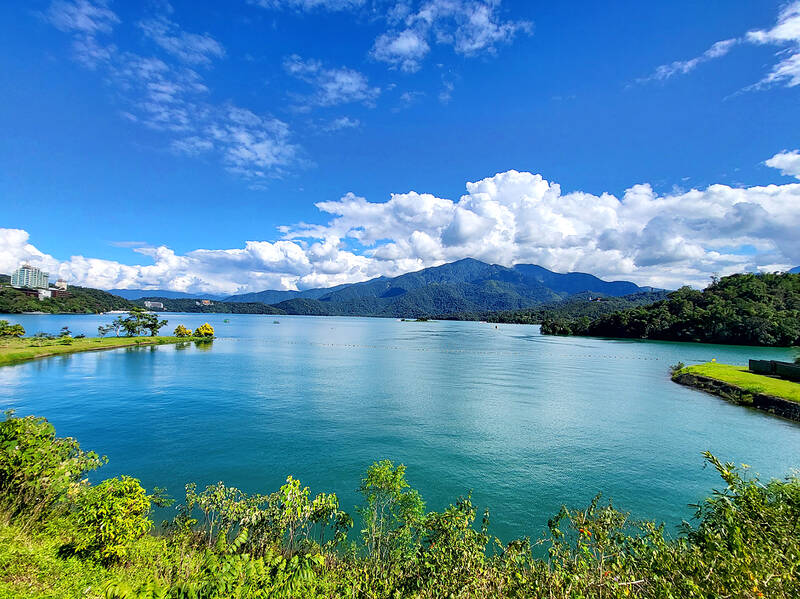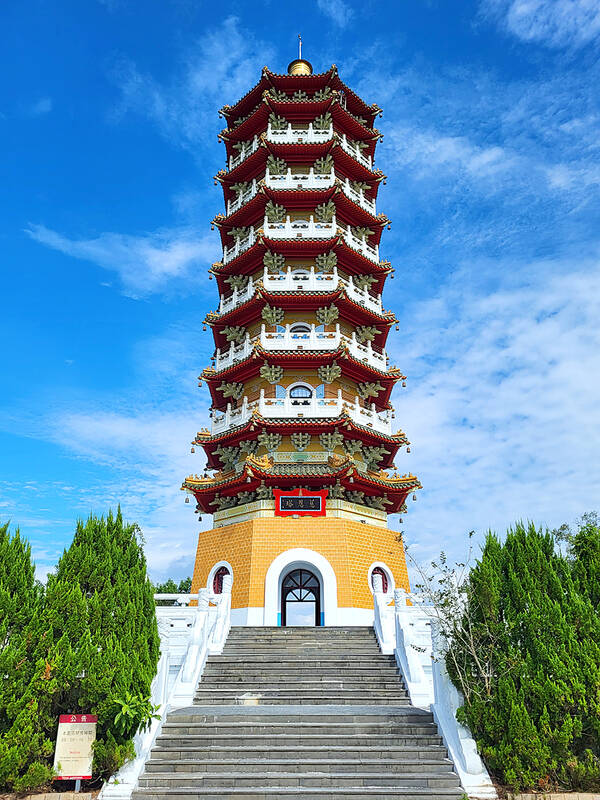Surrounding Sun Moon Lake (日月潭) there are a multitude of activities suitable for all the family that can be enjoyed on a day or weekend trip. On a recent visit, I hiked to a peak, rode a ferry across its emerald waters and a visited a pagoda with outstanding views.
Located in Nantou County’s Yuchi Township (魚池) at 748m above sea level, Sun Moon Lake it is an excellent destination in summer or winter with a year-round moderate temperature.
The lake is the largest body of water in Taiwan with a circumference of 27 kilometers. The east side of the lake resembles a sun while the west side resembles a moon — hence the name.

Photo courtesy of Mark Roche
MOUNTAIN HIGH
The lake and its surrounding countryside have been designated one of the thirteen national scenic areas in Taiwan. On a recent trip I enjoyed a walk along the Maolan Mountain Hiking Trail (貓囒山步道), which is located at the northern edge of the lake and rises to an elevation of 1,020 meters.
The Japanese colonial government established the Maolan Mountain Tea Research and Extension Station here in 1936, mainly to carry out the improvement of growing leaves for black tea.

Photo courtesy of Mark Roche
On the right side of the entrance to the trail there are several old Japanese-style buildings that houses employees for the tea research station that are made with cypress with the inside walls being of bamboo. They have been designated by the county government as an historic site.
The trees alongside the trail are Ceylon olive elaeocatpus, so-named because they are native to Sri Lanka (formerly Ceylon) and India and have fruit that resembles the olive. They are evergreen trees and the red leaves turn fiery red in the fall and winter and, when they fall, pave the ground with a red carpet that makes this a favorite place for taking wedding pictures.
The hike to the peak of the mountain, all on paved road, only takes an hour and is well worth the effort for the spectacular views of the whole area. The warm sunrise illuminates the tranquil lake water and the tea plantation that covers the mountainside, showing another side of the lake’s beauty. There is a weather station on top, which is one of the four highest in Taiwan.

Photo courtesy of Mark Roche
Maolan Mountain is also No. 49 of the Xiaobaiyue (小百岳) or “Small 100 Peaks” — specially selected “suburban mountains” that are more accessible in Taiwan’s cities and counties.
CRUISING THE LAKE
A visit to the lake wouldn’t be complete without enjoying the ferry service across it that connects the main tourist area piers of Shueishe (水社碼頭), Itathao (伊達邵碼頭) and Hsuanguang (玄光碼頭). This service, which triangulates between the three piers runs from 9am to 5pm daily and costs NT$30. Both Shueishe and Itathao have an abundance of guest houses and restaurants and either of these locations is ideal for an overnight stay.

Photo courtesy of Mark Roche
Taking the ferry across allows visitors to fully appreciate what a substantial body of water the lake is — the furthest points between the two main piers is nearly 3 kilometers in distance.
Although I didn’t do so on this occasion I would highly recommend renting a bike to enjoy the bike path that circles the lake. There is a Giant bicycle service station located at the Shueishe Pier. Rentals are reasonable and start at NT$200 per hour (e-bikes are also available).
PAGODA IN THE CLOUDS
One final place to visit is the Cien Pagoda, (慈恩塔), located just a few kilometers from either Itathao or Hsuanguang. Former president Chiang Kai-Shek (蔣介石) had it built in 1971 in an imposing traditional Chinese style in memory of his mother. The bamboo forest lining the route to the gardens at the top is the picture of tranquility.
The building in front of the pagoda was used as a rest house by Chiang and became one of his favorite places to visit.
The pagoda is 46 meters in height and sits on the 954 meter-high Shabalan Mountain (沙巴蘭山) bringing its top to an even 1,000 meters above sea level. The pagoda is an octagonal building; the three floors at the base are painted in white, while the nine floors of the main body are painted in golden red.
The view from the top offers spectacular views of Sun Moon Lake and the surrounding mountains.
Regardless of age, fitness or interests there is something for all the family to enjoy at the lake for a night or two and be sure of finish off your day at one of the many coffee shops or sipping a beer with a lake-side view.

In the March 9 edition of the Taipei Times a piece by Ninon Godefroy ran with the headine “The quiet, gentle rhythm of Taiwan.” It started with the line “Taiwan is a small, humble place. There is no Eiffel Tower, no pyramids — no singular attraction that draws the world’s attention.” I laughed out loud at that. This was out of no disrespect for the author or the piece, which made some interesting analogies and good points about how both Din Tai Fung’s and Taiwan Semiconductor Manufacturing Co’s (TSMC, 台積電) meticulous attention to detail and quality are not quite up to

April 21 to April 27 Hsieh Er’s (謝娥) political fortunes were rising fast after she got out of jail and joined the Chinese Nationalist Party (KMT) in December 1945. Not only did she hold key positions in various committees, she was elected the only woman on the Taipei City Council and headed to Nanjing in 1946 as the sole Taiwanese female representative to the National Constituent Assembly. With the support of first lady Soong May-ling (宋美齡), she started the Taipei Women’s Association and Taiwan Provincial Women’s Association, where she

It is one of the more remarkable facts of Taiwan history that it was never occupied or claimed by any of the numerous kingdoms of southern China — Han or otherwise — that lay just across the water from it. None of their brilliant ministers ever discovered that Taiwan was a “core interest” of the state whose annexation was “inevitable.” As Paul Kua notes in an excellent monograph laying out how the Portuguese gave Taiwan the name “Formosa,” the first Europeans to express an interest in occupying Taiwan were the Spanish. Tonio Andrade in his seminal work, How Taiwan Became Chinese,

Mongolian influencer Anudari Daarya looks effortlessly glamorous and carefree in her social media posts — but the classically trained pianist’s road to acceptance as a transgender artist has been anything but easy. She is one of a growing number of Mongolian LGBTQ youth challenging stereotypes and fighting for acceptance through media representation in the socially conservative country. LGBTQ Mongolians often hide their identities from their employers and colleagues for fear of discrimination, with a survey by the non-profit LGBT Centre Mongolia showing that only 20 percent of people felt comfortable coming out at work. Daarya, 25, said she has faced discrimination since she